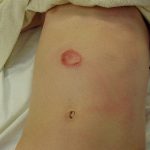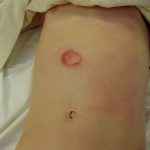Application of traction splints to the femur can be a bit tricky, mostly because of the various indications and contraindications. The company that makes the Hare traction splint gives the sole indication as a suspected femur fracture, and the sole contraindication as an open femur fracture. In my mind, this is a bit too simplistic.
I agree that the traction splint should only be applied on femur fractures, known or suspected. However, there are a few more contraindications:
- The patient should not have a posterior pelvic fracture. Unfortunately, prehospital providers don’t have xray vision, so they usually can’t tell. If there is any suspicion (pelvic instability, deformity), then don’t use it.
- The knee joint must be intact. Application of a traction splint across a bad knee will distract the tibia and the femur, potentially causing more injury. Take a good look at the knee. If it’s edematous or discolored, no traction splint.
- The tibia must not be fractured. As in the previous bullet point, the tibial segments will pull apart before the strong muscles in the thigh allow the femur to reduce.
What about the open fracture scenario? The concern is that contaminated bone will be pulled back into the wound. It’s not really known whether this results in an increased infection rate, but it’s better to be safe and not do it. However, there are two scenarios when applying traction to an open femur fracture is warranted:
- There is significant bleeding from the wound. Restoring the normal anatomy will create more pressure around the injured tissues and may slow bleeding.
- The distal pulses are compromised or absent. Most of the time, this is due to kinking of the vessel, not outright damage to it. Pulling it to length may restore normal flow.
Bottom line: Treat traction splints with respect. Keep these tips in mind, but always adhere to your local protocols and procedures first. However, if it’s not covered by them, or you are getting concerned that the patient’s (or their leg’s) wellbeing is at risk, do the right thing!
Thanks to Don Dustin from Mineral County EMS in Colorado for posing this question!




